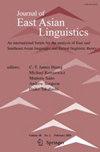调性(非)转移在昆明复制
IF 0.5
3区 文学
0 LANGUAGE & LINGUISTICS
引用次数: 1
摘要
在本文中,我讨论了昆明语的声调重复,这在形式语言学文献中很少受到关注。根据第一手资料,我认为昆明的声调重复在两个方面很有趣。首先,一个基音并不总是转移到红色(重复);当Hr(高音域)基音(即音平44、上声53)被传递到RED时,与Lr(低音域)基音(即阳平31、曲声11)对应的RED表面出现一个不对应的高音。我认为不对应的高音来自于伴随重复的浮动音,并且只在与Lr基音对应的RED上实现,而不是在Hr基音上实现,因为Hr基音在RED上突出且更容易保留。其次,就音平调变调而言,虽然它通常适用于基础和BR复合体之外,但在RED上,当RED携带从基础复制的音平调时,它意外地应用不足。我建议仅在复制的音平调上使用连读,而不是在其他地方使用连读,因为在这种情况下,只有在音平调上使用连读才能帮助改善BR识别。本文章由计算机程序翻译,如有差异,请以英文原文为准。
Tonal (non-)transfer in Kunming Reduplication
In this paper, I discuss tonal reduplication in Kunming, which has received little attention in the formal linguistics literature. Based on first hand data, I show that tonal reduplication in Kunming is interesting in two respects. First, a Base tone is not always transferred to the RED (reduplicant); while a Hr (high register) Base tone (i.e., yinping 44, shangsheng 53) is transferred to the RED, the RED corresponding to a Lr (low register) Base tone (i.e., yangping 31, qusheng 11) surfaces with a non-correspondent high tone. I propose that the non-corresponding high tone comes from a floating tone that accompanies reduplication and is only realized on the RED corresponding to Lr Base tones, but not to Hr Base tones, because Hr Base tones are prominent and more easily preserved on the RED. Second, as far as yinping tone sandhi is concerned, though it applies normally on the Base and outside the BR complex, on the RED it unexpectedly underapplies when the RED carries a yinping tone copied from the Base. I propose that tone sandhi underapplies only on a copied yinping tone, and not elsewhere, because only underapplication of yinping tone sandhi in this case can help improve BR Identity.
求助全文
通过发布文献求助,成功后即可免费获取论文全文。
去求助
来源期刊

Journal of East Asian Linguistics
Multiple-
CiteScore
0.90
自引率
0.00%
发文量
13
期刊介绍:
The study of East Asian languages, especially of Chinese, Japanese and Korean, has existed for a long time as a field, as demonstrated by the existence of programs in most institutions of higher learning and research that include these languages as a major component. Speakers of these three languages have shared a great deal of linguistic heritage during the development of their languages through cultural contacts, in addition to possible genealogical linkage. These languages accordingly possess various common features. Another important factor that ties them together as a field is that they have shared a common tradition of linguistic scholarship, a tradition that distinguishes itself from the study of western languages. Against this tradition, much recent work has approached these languages from a broader perspective beyond the area, considering them within contexts of general theoretical research, bringing new lights to old problems in the area and contributing to current issues in linguistic theory. But there continues to be good reason for scholars working in this approach to hold a special interest in each other''s work. Especially with the amount of most recent theoretical work on these languages, the field of theoretical East Asian linguistics has been fast growing. The purpose of the Journal of East Asian Linguistics is to provide a common forum for such scholarly activities, and to foster further growth that will allow the field to benefit more from linguistic theory of today, and enable the languages to play a more important role in shaping linguistic theory of tomorrow.
 求助内容:
求助内容: 应助结果提醒方式:
应助结果提醒方式:


